Collections
Library
Browse and search the IBD's collection of technical articles and videos
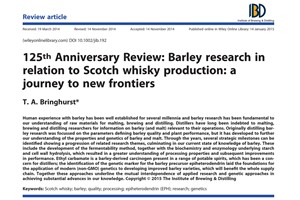 Open Access
Open Access
125th Anniversary Review: Barley research in relation to Scotch whisky production: a journey to new frontiers
By: T A Bringhurst
14/01/2015
Human experience with barley has been well established for several millennia and barley research has been fundamental to our understanding of raw materials for malting, brewing and distilling. Distillers have long been indebted to malting, brewing and distilling researchers for information on barley (and malt) relevant to their operations. Originally distilling barley research was focussed on the parameters defining barley quality and plant performance, but it has developed to further our understanding of the properties and genetics of barley and malt. Through the years, several strategic milestones can be identified showing a progression of related research themes, culminating in our current state of knowledge of barley. These include the development of the fermentability method, together with the biochemistry and enzymology underlying starch and cell wall hydrolysis, which resulted in a greater understanding of processing properties and subsequent improvements in performance. Ethyl carbamate is a barley-derived carcinogen present in a range of potable spirits, which has been a concern for distillers; the identification of the genetic marker for the barley precursor epiheterodendrin laid the foundations for the application of modern (non-GMO) genetics to developing improved barley varieties, which will benefit the whole supply chain. Together these approaches underline the mutual interdependence of applied research and genetic approaches in achieving substantial advances in our knowledge.
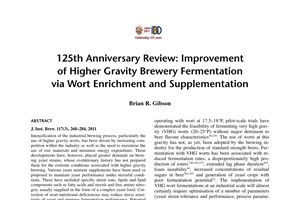 Open Access
Open Access
125th Anniversary Review: Improvement of Higher Gravity Brewery Fermentation via Wort Enrichment and Supplementation
By: Brian Gibson
16/05/2012
Intensification of the industrial brewing process, particularly the use of higher gravity worts, has been driven by increasing competition within the industry as well as the need to maximise the use of raw materials and minimise energy expenditure. These developments have, however, placed greater demands on brewing yeast strains, whose evolutionary history has not prepared them for the extreme conditions associated with higher gravity brewing. Various yeast nutrient supplements have been used or proposed to maintain yeast performance under stressful conditions. These have included specific metal ions, lipids and lipid components such as fatty acids and sterols and free amino nitrogen, usually supplied in the form of a complex yeast food. Correction of wort nutritional deficiencies may reduce stress sensitivity of yeast and improve fermentation performance. Potential negative consequences of altering wort composition must however be considered, as important beer quality attributes such as taste, stability and foam can be affected. Here, the various options for nutrient supplementation and their influence on yeast physiology and performance, as well as beer characteristics are considered.
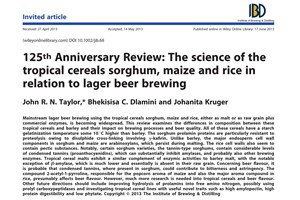 Open Access
Open Access
125th Anniversary Review: The science of the tropical cereals sorghum, maize and rice in relation to lager beer brewing
By: Bhekisisa Dlamini, Johanita Kruger, John Taylor
17/06/2013
Mainstream lager beer brewing using the tropical cereals sorghum, maize and rice, either as malt or as raw grain plus commercial enzymes, is becoming widespread. This review examines the differences in composition between these tropical cereals and barley and their impact on brewing processes and beer quality. All of these cereals have a starch gelatinization temperature some 10 C higher than barley. The sorghum prolamin proteins are particularly resistant to proteolysis owing to disulphide cross-linking involving g-kafirin. Unlike barley, the major endosperm cell wall components in sorghum and maize are arabinoxylans, which persist during malting. The rice cell walls also seem to contain pectic substances. Notably, certain sorghum varieties, the tannin-type sorghums, contain considerable levels of condensed tannins (proanthocyanidins), which can substantially inhibit amylases, and probably also other brewing enzymes. Tropical cereal malts exhibit a similar complement of enzymic activities to barley malt, with the notable exception of b-amylase, which is much lower and essentially is absent in their raw grain. Concerning beer flavour, it is probable that condensed tannins, where present in sorghum, could contribute to bitterness and astringency. The compound 2-acetyl-1-pyrroline, responsible for the popcorn aroma of maize and also the major aroma compound in rice, presumably affects beer flavour. However, much more research is needed into tropical cereals and beer flavour. Other future directions should include improving hydrolysis of prolamins into free amino nitrogen, possibly using prolyl carboxypeptidases and investigating tropical cereal lines with useful novel traits such as high amylopectin, high protein digestibility and low phytate
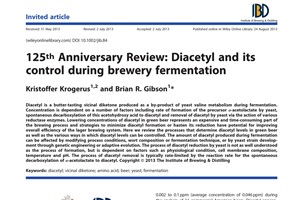 Open Access
Open Access
125th Anniversary Review: Diacetyl and its control during brewery fermentation
By: Kristoffer Krogerus, Brian Gibson
24/08/2013
Diacetyl is a butter-tasting vicinal diketone produced as a by-product of yeast valine metabolism during fermentation. Concentration is dependent on a number of factors including rate of formation of the precursor α-acetolactate by yeast, spontaneous decarboxylation of this acetohydroxy acid to diacetyl and removal of diacetyl by yeast via the action of various reductase enzymes. Lowering concentrations of diacetyl in green beer represents an expensive and time-consuming part of the brewing process and strategies to minimize diacetyl formation or hasten its reduction have potential for improving overall efficiency of the lager brewing system. Here we review the processes that determine diacetyl levels in green beer as well as the various ways in which diacetyl levels can be controlled. The amount of diacetyl produced during fermentation can be affected by modifying process conditions, wort composition or fermentation technique, or by yeast strain development through genetic engineering or adaptive evolution. The process of diacetyl reduction by yeast is not as well understood as the process of formation, but is dependent on factors such as physiological condition, cell membrane composition, temperature and pH. The process of diacetyl removal is typically rate-limited by the reaction rate for the spontaneous decarboxylation of α-acetolactate to diacetyl.
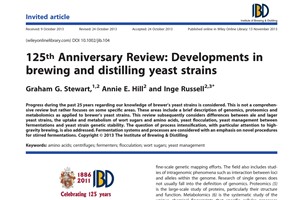 Open Access
Open Access
125th Anniversary Review: Developments in brewing and distilling yeast strains
By: Annie Hill, Inge Russell, Graham Stewart
13/11/2013
Progress during the past 25 years regarding our knowledge of brewer’s yeast strains is considered. This is not a comprehensive review but rather focuses on some specific areas. These areas include a brief description of genomics, proteomics and metabolomics as applied to brewer’s yeast strains. This review subsequently considers differences between ale and lager yeast strains, the uptake and metabolism of wort sugars and amino acids, yeast flocculation, yeast management between fermentations and yeast strain genetic stability. The question of process intensification, with particular attention to highgravity brewing, is also addressed. Fermentation systems and processes are considered with an emphasis on novel procedures for stirred fermentations.
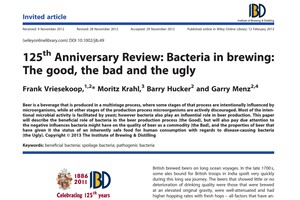 Open Access
Open Access
125th Anniversary Review: Bacteria in brewing: The good, the bad and the ugly
By: Frank Vriesekoop, Moritz Krahl, Barry Hucker, Garry Menz
12/02/2013
Beer is a beverage that is produced in a multistage process, where some stages of that process are intentionally influenced by microorganisms, while at other stages of the production process microorganisms are actively discouraged. Most of the intentional microbial activity is facilitated by yeast; however bacteria also play an influential role in beer production. This paper will describe the beneficial role of bacteria in the beer production process (the Good), but will also pay due attention to the negative influences bacteria might have on the quality of beer as a commodity (the Bad), and the properties of beer that have given it the status of an inherently safe food for human consumption with regards to disease-causing bacteria (the Ugly)
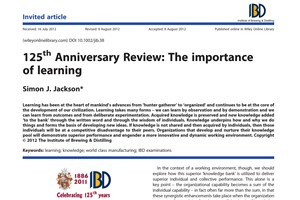 Open Access
Open Access
125th Anniversary Review: The importance of learning
By: Simon Jackson
08/08/2012
Learning has been at the heart of mankind’s advances from ‘hunter gatherer’ to ‘organized’ and continues to be at the core of the development of our civilization. Learning takes many forms – we can learn by observation and by demonstration and we can learn from outcomes and from deliberate experimentation. Acquired knowledge is preserved and new knowledge added ‘to the bank’ through the written word and through the wisdom of individuals. Knowledge underpins how and why we do things and forms the basis of developing new ideas. If knowledge is not shared and then acquired by individuals, then those individuals will be at a competitive disadvantage to their peers. Organizations that develop and nurture their knowledge pool will demonstrate superior performance and engender a more innovative and dynamic working environment.
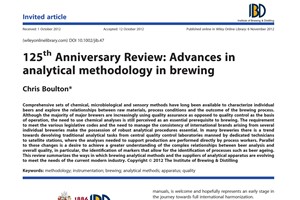 Open Access
Open Access
125th Anniversary Review: Advances in analytical methodology in brewing
By: Chris Boulton
06/11/2012
Comprehensive sets of chemical, microbiological and sensory methods have long been available to characterize individual beers and explore the relationships between raw materials, process conditions and the outcome of the brewing process. Although the majority of major brewers are increasingly using quality assurance as opposed to quality control as the basis of operation, the need to use chemical analyses is still perceived as an essential prerequisite to brewing. The requirement to meet the various legislative codes and the need to manage the consistency of international brands arising from several individual breweries make the possession of robust analytical procedures essential. In many breweries there is a trend towards devolving traditional analytical tasks from central quality control laboratories manned by dedicated technicians to satellite stations, where the analyses needed to support production are performed directly by process workers. Parallel to these changes is a desire to achieve a greater understanding of the complex relationships between beer analysis and overall quality, in particular, the identification of markers that allow for the identification of processes such as beer ageing. This review summarizes the ways in which brewing analytical methods and the suppliers of analytical apparatus are evolving to meet the needs of the current modern industry.
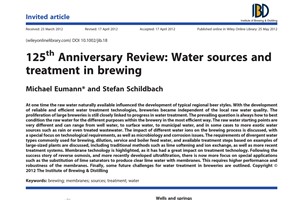 Open Access
Open Access
125th Anniversary Review: Water sources and treatment in brewing
By: Michael Eumann, Stefan Schildbach
25/05/2012
At one time the raw water naturally available influenced the development of typical regional beer styles. With the development of reliable and efficient water treatment technologies, breweries became independent of the local raw water quality. The proliferation of large breweries is still closely linked to progress in water treatment. The prevailing question is always how to best condition the raw water for the different purposes within the brewery in the most efficient way. The raw water starting points are very different and can range from well water, to surface water, to municipal water, and in some cases to more exotic water sources such as rain or even treated wastewater. The impact of different water ions on the brewing process is discussed, with a special focus on technological requirements, as well as microbiology and corrosion issues. The requirements of divergent water types commonly used for brewing, dilution, service and boiler feed water, and available treatment steps based on examples of large-sized plants are discussed, including traditional methods such as lime softening and ion exchange, as well as more recent treatment systems. Membrane technology is highlighted, as it has had a great impact on treatment technology. Following the success story of reverse osmosis, and more recently developed ultrafiltration, there is now more focus on special applications such as the substitution of lime saturators to produce clear lime water with membranes. This requires higher performance and robustness of the membranes. Finally, some future challenges for water treatment in breweries are outlined.
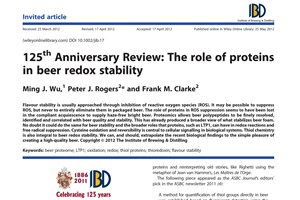 Open Access
Open Access
125th Anniversary Review: The role of proteins in beer redox stability
By: Ming Wu, Peter Rogers, Frank Clarke
25/05/2012
Flavour stability is usually approached through inhibition of reactive oxygen species (ROS). It may be possible to suppress ROS, but never to entirely eliminate them in packaged beer. The role of proteins in ROS suppression seems to have been lost in the compliant acquiescence to supply haze-free bright beer. Proteomics allows beer polypeptides to be finely resolved, identified and correlated with beer quality and stability. This has already produced a broader view of what stabilizes beer foam. No doubt it could do the same for beer stability and the broader roles that proteins, such as LTP1, can have in redox reactions and free radical suppression. Cysteine oxidation and reversibility is central to cellular signalling in biological systems. Thiol chemistry is also integral to beer redox stability. We can, and should, extrapolate the recent biological findings to the simple pleasure of creating a high-quality beer.
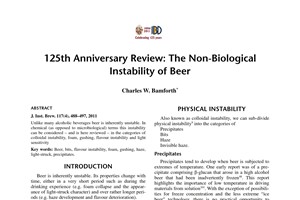 Open Access
Open Access
125th Anniversary Review: The Non-Biological Instability of Beer
By: Charlie Bamforth
16/05/2012
Unlike many alcoholic beverages beer is inherently unstable. In chemical (as opposed to microbiological) terms this instability can be considered – and is here reviewed – in the categories of colloidal instability, foam, gushing, flavour instability and light sensitivity
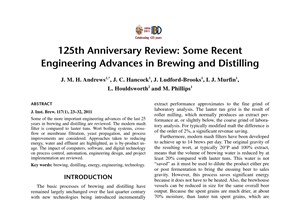 Open Access
Open Access
125th Anniversary Review: Some Recent Engineering Advances in Brewing and Distilling
By: John Andrews, John Hancock
16/05/2012
Some of the more important engineering advances of the last 25 years in brewing and distilling are reviewed. The modern mash filter is compared to lauter tuns. Wort boiling systems, crossflow or membrane filtration, yeast propagation, and process improvements are considered. Approaches taken to reducing energy, water and effluent are highlighted, as is by-product usage. The impact of computers, software, and digital technology on process control, automation, engineering design, and project implementation are reviewed.
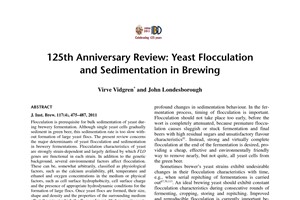 Open Access
Open Access
125th Anniversary Review: Yeast Flocculation and Sedimentation in Brewing
By: Virve Vidgren, John Londesborough
16/05/2012
Flocculation is prerequisite for bulk sedimentation of yeast during brewery fermentation. Although single yeast cells gradually sediment in green beer, this sedimentation rate is too slow without formation of large yeast flocs. The present review concerns the major determinants of yeast flocculation and sedimentation in brewery fermentations. Flocculation characteristics of yeast are strongly strain-dependent and largely defined by which FLO genes are functional in each strain. In addition to the genetic background, several environmental factors affect flocculation. These can be, somewhat arbitrarily, classified as physiological factors, such as the calcium availability, pH, temperature and ethanol and oxygen concentrations in the medium or physical factors, such as cell surface hydrophobicity, cell surface charge and the presence of appropriate hydrodynamic conditions for the formation of large flocs. Once yeast flocs are formed, their size, shape and density and the properties of the surrounding medium affect the rate at which the flocs sediment. Higher gravity worts usually result in green beers with higher viscosity and density, which both retard sedimentation. Moreover, environmental factors during yeast handling before fermentation, e.g., propagation, storage and cropping, influence the flocculation potential of yeast in subsequent fermentation. Premature yeast flocculation (PYF) and the role of PYF factors are discussed. In conclusion, some potential options available to adjust yeast flocculation are described.
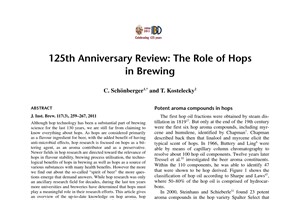 Open Access
Open Access
125th Anniversary Review: The Role of Hops in Brewing
By: Christina Schönberger, Tim Kostelecky
16/05/2012
Although hop technology has been a substantial part of brewing science for the last 130 years, we are still far from claiming to know everything about hops. As hops are considered primarily as a flavour ingredient for beer, with the added benefit of having anti-microbial effects, hop research is focused on hops as a bittering agent, as an aroma contributor and as a preservative. Newer fields in hop research are directed toward the relevance of hops in flavour stability, brewing process utilisation, the technological benefits of hops in brewing as well as hops as a source of various substances with many health benefits. However the more we find out about the so-called “spirit of beer” the more questions emerge that demand answers. While hop research was only an ancillary research field for decades, during the last ten years more universities and breweries have determined that hops must play a meaningful role in their research efforts. This article gives an overview of the up-to-date knowledge on hop aroma, hop derived bitterness, and the role of hops in flavour stability as well as light stability. Hop research is a wide field, therefore in this review only selected topics are reviewed. Other research areas such as hops utilisation, the antifoam potential of hops, or the advances in knowledge pertaining to the physiological valuable substances of hops go beyond the scope of this article.
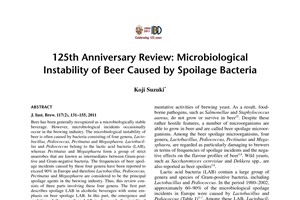 Open Access
Open Access
125th Anniversary Review: Microbiological Instability of Beer Caused by Spoilage Bacteria
By: Koji Suzuki
16/05/2012
Beer has been generally recognized as a microbiologically stable beverage. However, microbiological incidents occasionally occur in the brewing industry. The microbiological instability of beer is often caused by bacteria consisting of four genera, Lactobacillus, Pediococcus, Pectinatus and Megasphaera. Lactobacillus and Pediococcus belong to the lactic acid bacteria (LAB), whereas Pectinatus and Megasphaera form a group of strict anaerobes that are known as intermediates between Gram-positive and Gram-negative bacteria. The frequencies of beer spoilage incidents caused by these four genera have been reported to exceed 90% in Europe and therefore Lactobacillus, Pediococcus, Pectinatus and Megasphaera are considered to be the principal spoilage agents in the brewing industry. Thus, this review consists of three parts involving these four genera. The first part describes spoilage LAB in alcoholic beverages with some emphasis on beer spoilage LAB. In this part, the emergence and evolution of these spoilage LAB is discussed, the insight of which is useful for developing quality control methods for these beverages. The second part is devoted to the hop resistance in beer spoilage LAB. This area of research is evolving rapidly and recent progress in this field is summarized. The third part concerns Pectinatus and Megasphaera. Although this group of beer spoilage bacteria has been described relatively recently, the incident reports in Europe increased in the early 1990s, reaching around 30% of spoilage incidents. Various aspects of Pectinatus and Megasphaera, ranging from their taxonomy and beer spoilage ability to detection and eradication methods are described.
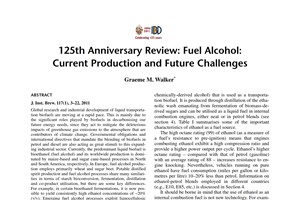 Open Access
Open Access
125th Anniversary Review: Fuel Alcohol: Current Production and Future Challenges
By: Graeme Walker
16/05/2012
Global research and industrial development of liquid transportation biofuels are moving at a rapid pace. This is mainly due to the significant roles played by biofuels in decarbonising our future energy needs, since they act to mitigate the deleterious impacts of greenhouse gas emissions to the atmosphere that are contributors of climate change. Governmental obligations and international directives that mandate the blending of biofuels in petrol and diesel are also acting as great stimuli to this expanding industrial sector. Currently, the predominant liquid biofuel is bioethanol (fuel alcohol) and its worldwide production is dominated by maize-based and sugar cane-based processes in North and South America, respectively. In Europe, fuel alcohol production employs primarily wheat and sugar beet. Potable distilled spirit production and fuel alcohol processes share many similarities in terms of starch bioconversion, fermentation, distillation and co-product utilisation, but there are some key differences. For example, in certain bioethanol fermentations, it is now possible to yield consistently high ethanol concentrations of ~20% (v/v). Emerging fuel alcohol processes exploit lignocellulosic feedstocks and scientific and technological constraints involved in depolymerising these materials and efficiently fermenting the hydrolysate sugars are being overcome. These so-called secondgeneration fuel alcohol processes are much more environmentally and ethically acceptable compared with exploitation of starch and sugar resources, especially when considering utilisation of residual agricultural biomass and biowastes. This review covers both first and second-generation bioethanol processes with a focus on current challenges and future opportunities of lignocellulose-to-ethanol as this technology moves from demonstration pilot-plants to full-scale industrial facilities.
